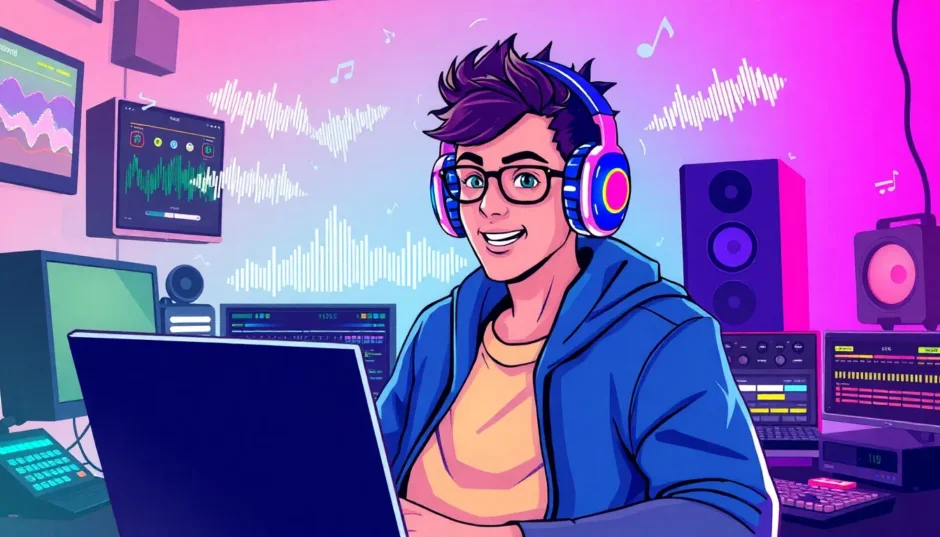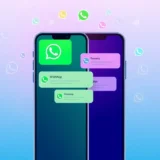Ever thought about how cool it would be to sound totally different while gaming with friends or during a voice call? Maybe you want to sound like a robot, a famous singer, or just disguise your voice for fun. Well, you’re definitely not the only one! A lot of people are getting into voice changing just to make everyday chats and online moments more entertaining. That’s where RVC voice changers jump in—they let you modify how you sound in real time. Whether you’re into gaming, creating content, or just messing around, RVC voice changers open up a whole new playground for audio fun.
In this guide, we’ll walk through all the basics and not-so-basics of RVC voice changers. We’ll cover what they are, why they’re useful, and list some easy options for people just starting out. Plus, we’ll share pro tips for making your modified voice sound super natural, and even how to tweak things further using a video editor. Ready to find out more? Let’s jump right in!
Table of Contents
What Exactly is an RVC Voice Changer?
Okay, so first things first—what does RVC even mean? RVC stands for Retrieval-based Voice Conversion. In simple words, it’s a type of smart technology that uses artificial intelligence to transform one person’s voice into another, while keeping the original way of speaking intact. That means your pitch, tone, and unique style don’t get lost—it still sounds like “you,” just a different version!
RVC voice changers rely on deep learning and smart audio matching to do this. They’re super handy for loads of things, like dubbing cartoons, creating digital personas, making song covers, or just adding flair to your YouTube videos. The tech behind RVC voice changers keeps getting better, and nowadays, they’re easier to use than ever.
Cool Ways to Use RVC Voice Changers
One of the best things about RVC voice changers is how flexible they are. No matter if you’re looking to have a laugh with friends or produce pro-level content, there’s probably a use case that fits. Let’s look at some of the top ways people are using RVC voice changers today.
Live voice changing is probably the most popular use. Imagine you’re streaming on Twitch or in a Discord chat with buddies. With a real-time RVC voice changer, you can sound like a deep-voiced announcer, a squeaky character, or anything in between—right while you talk! It’s not only fun but also great for gamers who want a bit of anonymity.
Then there’s making AI music covers. Have you ever wanted to sing like your favorite artist but didn’t have the vocal chops? With RVC voice changers, you can! Many musicians and hobbyists use this tech to create song covers in the style of famous singers, without needing any special singing skills. It’s creative, it’s fun, and you might even go viral!
Voice dubbing for characters is another awesome application. If you’re working on an animation, game mod, or even a school project, giving each character a unique voice is way easier with an RVC voice changer. It saves you time looking for voice actors and lets you control exactly how each persona sounds.
Content creators—YouTubers, podcasters, TikTokers—also love RVC voice changers. Changing your voice can help you tell stories in a more engaging way, produce character-driven content, or simply keep your real identity private. It’s a simple tool that can make a big difference in your productions.
And let’s not forget custom voiceovers. Need a voice for your presentation, ad, or tutorial? Instead of hiring someone, you can use an RVC voice changer to generate clean, natural-speech voiceovers in various styles. It’s budget-friendly and super quick.
5 Easy-to-Use RVC Voice Changers for Beginners
If you’re new to all this, don’t worry—there are plenty of user-friendly RVC voice changers out there that won’t make your head spin. Here are five great ones that are perfect for beginners.
RVC GUI
RVC GUI is a straightforward and effective tool that’s ideal if you’re just getting started with RVC voice changers. It works great for gaming, streaming, or casual chatting, and it lets you switch up your voice quickly and easily. You get a bunch of voice styles to pick from, and it integrates smoothly with platforms like Discord. The interface is clean and simple, so you won’t get lost in complicated settings. It also works in real time with very little lag, which is awesome for live conversations.
What’s good about it? The interface is beginner-friendly, it works flawlessly with Discord, there’s low delay during use, and you get plenty of voice options. On the flip side, the free version has limited styles, and you need an internet connection for it to work.

UnicTool MagicVox
UnicTool MagicVox is another easy pick, especially if you use Discord a lot. It lets you change your voice on the fly while you’re chatting, with fun presets and sliders to adjust pitch and effects in just minutes. The sound quality remains clear, so your friends won’t hear weird echoes or distortions. It’s perfect for gaming sessions, live streams, or just hanging out online.
Pros include simple setup with helpful guides, high-quality audio output, customizable presets, and support for lots of apps. Cons? It might act up in advanced settings occasionally, and the free version is pretty basic.

Voice.ai
Voice.ai offers a simple, AI-powered RVC voice changer that works almost instantly. It comes with dozens of preset voices, and you can toggle between them in seconds. The layout is intuitive, so even new users can try out different sounds during streams or calls without confusion. It also plays nicely with popular apps like Discord, Zoom, and OBS.
On the plus side: super fast voice switching, real-time performance with low lag, multi-platform support, and a clean interface. Downsides: not a lot of custom voice options, and it might have compatibility issues on some devices.

EaseUS
EaseUS offers an RVC AI voice changer aimed at beginners, focusing on clear voice effects and simplicity. It allows you to record and modify your voice with just a few clicks. This is especially handy for content creators who want to do quick voice edits without extra software. It supports various voice styles and works well with Discord and other communication apps. The layout is clean and easy to navigate.
Benefits include easy recording and editing, good for content creation, smooth and clear voice effects, and wide app compatibility. Drawbacks: it lacks advanced features, and some voices may still sound a bit robotic.

MimicPC
MimicPC is a no-fuss voice changer built mainly for Discord. It’s all about keeping things fun and straightforward. You can swap your voice in real time using heaps of preset options. People love how fast it installs and how reliably it works during voice chats or streams. Since it changes your voice with almost no delay, it’s perfect for those who want something simple and effective.
Pros: quick to set up and use, great for live chats, lots of preset voices, and low latency. Cons: not many voice editing tools, and it might crash on older computers.

Pro Tips for High-Quality Voice Conversion with RVC Voice Changers
If you want your voice to sound believable and natural after conversion, a few expert tips can make a big difference. Here’s how to get the best results from your RVC voice changer.
Start with clean source audio. This one’s super important! If your original recording is clear—without background noise or muffled sound—the AI will have a much easier time processing it. So use a decent mic and record somewhere quiet.
Use a balanced dataset. This means feeding the AI a variety of voice samples with different accents, emotions, and speaking styles. The more diverse your samples, the better the tool can mimic natural speech and avoid weird tones or mispronunciations.
Pay attention to pitch. Pitch determines how high or low your voice sounds. Getting this right is key to making your modified voice sound natural. Most tutorials on RVC voice changers will show you how to adjust pitch settings properly—don’t skip this step!
Tweak model settings. Adjusting settings like speech speed, warmth, or clarity can help match the output to your specific voice or project. Small changes here can make the converted voice sound much more realistic.
Finish with EQ. An equalizer (or EQ) helps balance sound frequencies, reduce unwanted noise, and improve clarity. Using an EQ after voice conversion gives your audio a polished, professional touch.
By keeping these tips in mind, you can make the most of RVC voice changers and create voice tracks that sound smooth and authentic. And if you’re working with video, pairing your RVC tool with a video editor like CapCut can take your results to the next level.
CapCut — Your all-in-one video & photo editing powerhouse! Experience AI auto-editing, realistic effects, a huge template library, and AI audio transformation. Easily create professional masterpieces and social media viral hits. Available on Desktop, Web, and Mobile App.
Extra Tip: Adjusting Voice Tone and Style in Videos with CapCut
After you’ve used an RVC voice changer, you might want to do some final tweaks—especially if you’re using the audio in a video. That’s where CapCut desktop video editor shines. It’s a powerful, easy-to-use tool that lets you fine-tune voice sound, apply audio effects, and blend everything seamlessly with your video clips. It’s a favorite among content creators and streamers for making high-quality videos quickly.
CapCut comes with tons of useful features. For example, you can change voices in videos using AI—choose from over 350 realistic AI voices. This is perfect for creating characters, making stories more engaging, or keeping your identity private. There’s also a library of free AI voiceovers, so you can add narration without recording your own voice.
You can easily adjust audio pitch, apply effects like echo or reverb, and export your video with crisp, clear sound. With CapCut, your voiceovers will sound pro-level and ready to share anywhere.
How to Change a Voice in a Video Using CapCut
Using CapCut to modify voice in videos is simple. First, download and install CapCut desktop video editor from the official site. Once it’s installed, just follow these steps:
Import your video and audio files into CapCut. You can click “Import” or drag and drop them right into the editor. Then place them on the timeline to start working.
Trim or split your audio clip to the desired length. Use the split tool to remove any parts you don’t need. Then, select your audio, go to the “Voice changer” tab, and pick an effect—like Queen, Echo, or Chipmunk. Apply it with one click. You can also add a visual filter from the “Filters” tab to enhance your video.
When you’re done, hit the “Export” button at the top. Choose your preferred format and quality, then export. You can even share it straight to social media from the app.


CapCut — Your all-in-one video & photo editing powerhouse! Experience AI auto-editing, realistic effects, a huge template library, and AI audio transformation. Easily create professional masterpieces and social media viral hits. Available on Desktop, Web, and Mobile App.
Wrapping Up
RVC voice changers are fun, creative, and super useful—whether you’re messing around with friends or producing content. They let you change your voice in real time, express yourself in new ways, and even maintain privacy. With the right tool and a few expert tips, you can make your modified voice sound clear and natural.
And if you’re editing videos, don’t forget that tools like CapCut can help you polish your audio even further. So go ahead, experiment with different RVC voice changers, and most importantly—have fun with it!
Frequently Asked Questions
Can I use RVC voice changer models on different devices?
In most cases, yes. Lots of RVC voice changer models work across Windows, macOS, and even some mobile apps. But performance can vary based on your device and the software you’re using. Some models might need specific settings for optimal results. If you need to edit your audio afterward, CapCut desktop video editor is a user-friendly option.
Do I need a powerful computer to run an AI RVC voice changer?
Not necessarily. Some AI RVC voice changers work fine on mid-range computers, but a higher-end PC will handle real-time processing more smoothly. If your computer isn’t top-of-the-line, try lowering the settings for better performance. CapCut also runs well on most average computers, which is handy for editing.
Are RVC voice changers useful for content creators?
Definitely! RVC voice changers are great for content creators who want to add variety, creativity, or anonymity to their videos. They save time and allow for more imaginative storytelling. Plenty of YouTubers, streamers, and podcasters use them to make their content stand out. For even more audio control, CapCut offers additional editing features.
Some images sourced from CapCut.
 TOOL HUNTER
TOOL HUNTER



